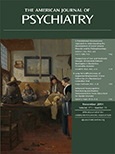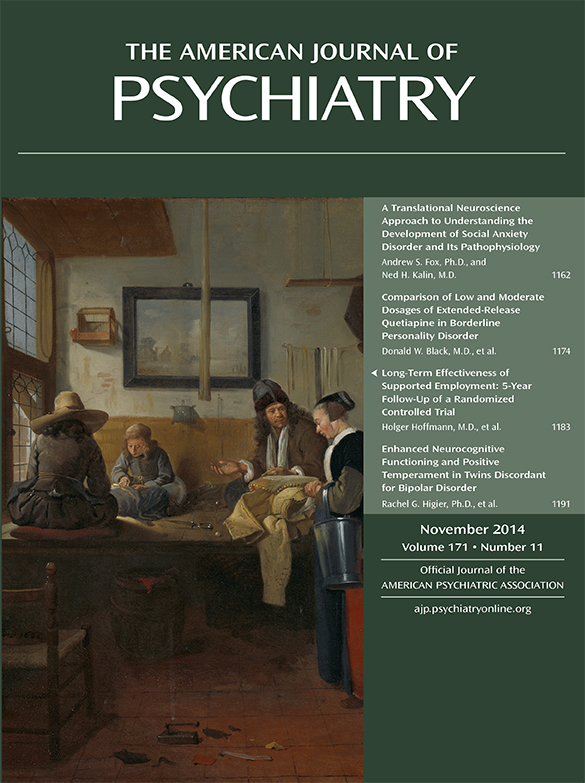Following a competitive application process sponsored by the National Institute of Mental Health (NIMH), the Measurement and Treatment Research to Improve Cognition in Schizophrenia (MATRICS) initiative was launched. After 2 years of large consensus meetings, a five-site psychometric and validation study, complex intellectual property agreements, and an endorsement by NIMH and the U.S. Food and Drug Administration (FDA), the MATRICS Consensus Cognitive Battery (MCCB) was initially presented in a series of three articles in the
Journal in 2008 (
1–
3). Since then, the MCCB has been evaluated and scrutinized in a way that few test assessment batteries have been. Over time its strengths and limitations have come into sharper focus, and we believe it is a good time to review what we know about the MCCB 6 years later.
The MATRICS initiative was designed to address a particular issue—the FDA was previously unwilling to approve a drug for enhancing cognition in schizophrenia without consensus on domains, measurement, and study design (
4,
5). The overarching goal of MATRICS was to construct a pathway for drug approval in this area. Identifying consensus cognitive domains and developing a consensus battery were part of the broader MATRICS agenda that included agreement on study design, subject selection, neuropharmacological targets, and government-industry interactions. Though it was only one component of a much larger initiative, the MCCB was the most concrete deliverable. The components of the MCCB were selected through both consensus and data collection methods (
1,
6). The first step was to agree on cognitive domains that should be represented in schizophrenia treatment trials (
7) and then to select tests at the domain level on the basis of a priori criteria. It was hoped that the MCCB would behave well in clinical trials, but that was an educated guess at the time. In this commentary we will summarize recent results regarding the test qualities of the MCCB when used in multisite clinical trials, its sensitivity to treatment effects, and its covariation with biomarkers.
MCCB Psychometric Properties in Multisite Clinical Trials
•
The completeness of the MCCB data in clinical trials is impressive. In a 29-site study in which 323 patients were tested twice, 98.5% of the assessments were complete (
8). Because data can be imputed (recommendations are a minimum of five of seven domains assessed at baseline and four of seven domains at follow up), only one assessment out of 646 was missing.
•
The MCCB tests were selected for high test-retest reliability (reliability of the overall composite score was 0.90 in the initial validation study). This value has been consistently found in multisite clinical trials. For example, the reliability was 0.88 in the 29-site study mentioned above (
8) and has been even higher (0.93, 0.95) in other published clinical trials (
9,
10).
•
Practice effects of the MCCB seen in the context of clinical trials are modest. The practice effect, measured before initiation of treatment, in the 29-site study was 0.18, or about one-fifth of a standard deviation (
8). Other multisite studies (e.g.,
10) obtained similar values for practice effects.
MCCB Sensitivity to Training and Psychopharmacological Interventions
Numerous studies have examined the MCCB’s sensitivity to treatment effects. The published results have been most impressive for the cognitive training interventions, and results are now also emerging for psychopharmacological interventions. Some of the studies started after the tests in the MCCB were selected but before the packaged commercial battery was available. These studies are still informative about the sensitivity of the battery, even though they did not use the MCCB scoring program.
•
The MCCB was sensitive to the cognition-enhancing effects of 50 hours of neuroplasticity-based auditory training when compared with a control condition (
11).
•
A more recent publication with 40 hours of neuroplasticity-based training in recent-onset patients similarly found improvements in the MCCB (
12).
•
The MCCB was sensitive to the effects of a cognitive remediation program in a multisite feasibility study. The effects were significant at the midpoint assessment, relative to the effects of a control condition, and showed a nonsignificant tendency at the end of the study, when the sample size was smaller (
13).
•
A randomized controlled (2×2) trial of both long-acting versus oral antipsychotic medication and cognitive remediation versus healthy behavior training in first-episode schizophrenia found that the MCCB detected significant cognitive improvement for antipsychotic medication adherence (
14) and also for cognitive remediation (
15).
•
A clinical trial with patients in a partial hospital program showed that the MCCB reflected improvements with attention-shaping procedures versus a control condition in these low-functioning patients (
16).
•
Transcranial direct current stimulation showed significant improvement on the MCCB composite, when compared with a sham control condition (
17).
•
In a study with an α
7 nicotinic partial agonist, beneficial results were at the trend level on the MCCB composite for the entire sample, and effects were significant for patients who were retested at the same time of day as they were tested at baseline and for patients who were age 45 years or less (
18).
•
The MCCB showed significant beneficial effects of add-on sodium benzoate therapy (a
d-amino acid oxidase inhibitor) when compared with placebo. This study focused on the MCCB neurocognitive composite (composite of all of the domains except social cognition) (
19).
•
A study with an α
7 nicotinic agonist demonstrated a significant group-by-smoking interaction, in that nonsmoking patients showed a significant improvement on the MCCB neurocognitive composite that was larger than the effect in smoking patients (
20).
Biomarkers of MCCB Performance
Therapeutic development for cognitive deficits in schizophrenia is greatly facilitated if we can identify biomarkers to determine whether the therapeutic candidates elicit their targeted biological effects. Two studies illustrate the utility of the MCCB in this regard.
•
In a study using magnetic resonance spectroscopy, NAA/Cr correlated with the composite MCCB score (r=0.52), as well as with scores for the domains of attention/vigilance, verbal learning, and social cognition (
21).
•
Right hippocampal fMRI hyperactivity identified in patients with schizophrenia was associated with lower MCCB composite scores (r=0.53). Exploratory analyses revealed the effect was driven by associations between activity and attention/vigilance, working memory, and visual learning (
22).
New Developments
Two updates to the MCCB are reflected in some of the bulleted items above and deserve mention. First, the MCCB was developed to facilitate drug approval from the U.S. FDA. Because clinical trials are often international, it soon became obvious that a key limitation of the MCCB was that it was available only in English. Hence, the MCCB has now been professionally translated and is commercially available in over 20 languages (see
www.matricsinc.org for a listing). With the help of an industry-academic-government consortium (MATRICS-CT) (
23), we also collected representative normative data in key countries and are using these norms to create international scoring programs. A second change reflects the growing awareness that nonsocial cognition and social cognition are separable dimensions. It is possible that a treatment will affect social cognition and nonsocial cognition differently, and that is assumed for specific interventions, such as oxytocin, that are focused on one area or the other. To allow trial investigators to examine nonsocial cognition only, the MCCB scoring program now provides an option for a “neurocognitive composite” that does not include social cognition. A limitation of the MCCB is that it does not have an option for a social cognition composite, because there is only one test in that domain.
Summary
After substantial use in the testing ground of multisite clinical trials, the MCCB has demonstrated impressive psychometrics. It has shown sensitivity to improvement from interventions, most notably for cognitive training interventions so far. We do not believe that the MCCB is inherently more sensitive to training than to pharmacological interventions; that pattern most likely reflects the state of that field, in which we have few validated cognition-enhancing drugs. The MCCB also tracks with key biomarkers, which is an important feature as efforts are made to apply experimental medicine principles, such as target engagement, to psychiatric treatment trials.

